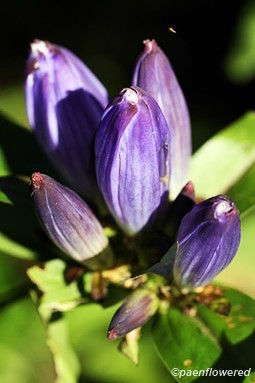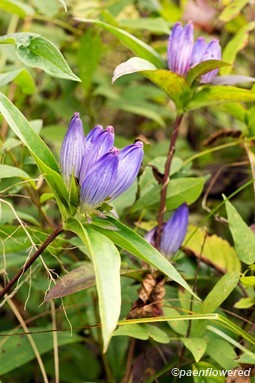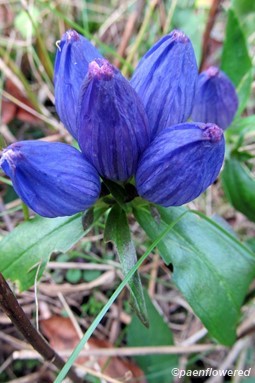Gentiana andrewsii
Gentiana andrewsii closed bottle gentian
This is one wildflower that is easiest to see after the first frost of autumn kills some of the surrounding vegetation that may otherwise hide it from view. A keen eye can spot it growing in thickets among other vegetation. It is one of several members of the gentian family in the Eastern United States. All of these species have erect tubular flowers. In the case of the closed bottle gentian, the deep blue-violet flowers stay closed, joined by a fringed whitish membrane. Thus they look more like buds than flowers.
There are 5 lobes or petals but these are hard to distinguish because they do not separate and are often hidden by the membrane. There are vertical ridges along the sides of each flower. Each flower is about 1 to 1.5 inches long. There is no noticeable floral scent. The only effective pollinators are bumblebees that can force their way into the flower to reach the nectar. Thus smaller and less efficient pollinators are excluded. Inside the reproductive structures are fused together into a central column. The seeds are small and are distributed by wind or water.
The plant grows one to two feet tall in moist meadows and other wet areas. It is found in eastern Canada and northeastern and north-central United States. It is officially listed as threatened in Maryland, Massachusetts, New Hampshire, and Vermont and vulnerable in New York. It blooms from August to October growing each year from its taproot. The leaves are about 4.5 inches long and about 2 inches wide and are opposite on the smooth stem.
A very similar species (G. clausa) has petal tips that are not covered by the joining membrane. The soapwort gentian (G. saponaria) is also similar but has flowers that are paler in color or even white and which open slightly. This species is one of the most abundant of the Gentian group. Although herbivores avoid eating the leaves, white-tailed deer and other animals may nip off the growing tip before it can generate flowers. It is also known as the fringe-tip closed gentian, Andrew’s bottle gentian, Andrew's gentian, and closed gentian.
Habitat & Range
Occasional in moist to wet fields, open woods, and swamps in calcareous soils or diabase.
Mostly present in the south.
| EMP: | FACW |
|---|---|
| NCNE: | FACW |
Phenology
Flowers late July to early November.
Plant Codes
S-rank: No rank
G-rank: G5 (Secure)







Comments
Have you spotted this plant in your area? We'd love to hear about your experience! Share your comments or questions about the plant below. Comments are moderated before posting.